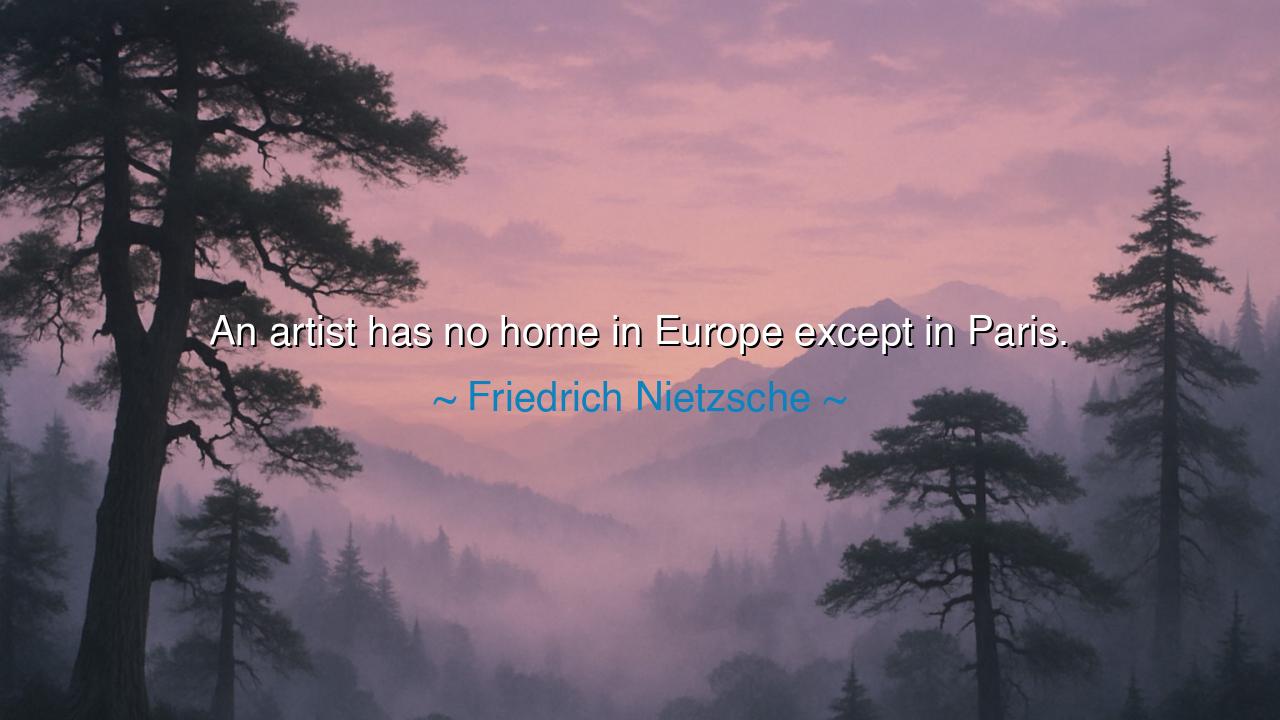
An artist has no home in Europe except in Paris.






The philosopher Friedrich Nietzsche, that fierce prophet of individuality and creation, once wrote: “An artist has no home in Europe except in Paris.” In this statement lies both admiration and melancholy — a recognition that true artistic spirit rarely finds rest, and that only in certain sacred places does it breathe freely. To Nietzsche, Paris was not merely a city; it was the altar of genius, the one refuge in a continent grown cautious, polite, and stale. In his eyes, the artist — that eternal rebel, dreamer, and truth-seeker — belonged nowhere else, for only there did the flame of imagination burn bright enough to keep the soul alive.
To grasp the meaning of this saying, one must remember that Nietzsche lived in an age when the winds of industrial progress were sweeping across Europe, smothering the delicate fires of art beneath the weight of conformity. The world was becoming mechanical, efficient, and gray. In such a time, Paris stood apart — chaotic, luminous, daring. It was the city of revolution, both political and creative; the city of poets and painters who refused to kneel before mediocrity. Nietzsche saw in Paris a sanctuary for the spirit — a place where the artist’s defiance was not punished, but celebrated. For him, to live there was not merely to dwell among buildings, but to breathe among the gods of human imagination.
When Nietzsche said that the artist had “no home except in Paris,” he was also speaking of the homelessness of genius. The artist, by nature, is a wanderer — too strange for the common world, too passionate for the ordinary. He belongs everywhere and nowhere, forever exiled from the comfort of acceptance. But in Paris, Nietzsche saw a rare harmony between rebellion and belonging — a place where the exile might finally rest, if only for a moment. It was there that art was not seen as madness but as necessity; there that beauty was not confined by custom, but expanded into new forms with fearless vitality.
Throughout history, this vision of Paris as the sanctuary of the soul proved true. In the cafés of Montparnasse and Montmartre, artists like Pablo Picasso, Ernest Hemingway, and Gertrude Stein gathered like pilgrims around a sacred flame. They came from every nation — Spain, America, Russia, Italy — each seeking what their own homelands could not give them: freedom to create without judgment. In Paris, they were outsiders together. The walls echoed with laughter, debate, and the clinking of glasses, but beneath it all was something profound — the shared understanding that art was the last bastion of human truth in an age of imitation. Nietzsche’s words could have been their anthem, whispering over every cobblestone street: “Here, at last, the artist is home.”
The origin of this quote can be found not only in Nietzsche’s observation of the world around him, but in his own life. He was a thinker perpetually at odds with society, rejected by institutions, misunderstood by peers. He knew what it was to wander in both body and spirit. His declaration was less about geography than about freedom of the soul. Paris, to him, was a symbol — the embodiment of what happens when a people dare to let creativity reign over convention, when they allow art to shape culture instead of culture shaping art. In that vision, Paris was not merely French; it was universal, the home of every spirit that refuses to bow to banality.
Yet even in its beauty, Nietzsche’s statement carries sorrow. It is the sorrow of knowing that art rarely finds acceptance among the comfortable. The artist must often leave behind his homeland, his family, his ease, to find a place where his fire will not be extinguished. This is the price of creation: exile in pursuit of expression. Nietzsche himself lived much of his life alone, wandering through the Alps, writing words that few understood in his time. Like the artists of Paris, he bore the loneliness of vision — and in his loneliness, he exalted the city that made a home for the misunderstood.
The lesson, then, is twofold. For those who create, it is a call to seek the place — or the spirit — that nourishes your art, even if the world rejects you. Every artist must find their own “Paris,” their own sanctuary of authenticity. It may not be a city; it may be a community, a friendship, a quiet space in the heart — but it must be a place where truth can breathe. And for those who live among creators, the teaching is this: honor the artist, even when their light seems strange or blinding. For their vision shapes the future that others will one day call their home.
Thus, Nietzsche’s words endure not merely as a tribute to one city, but as an eternal parable. Paris stands as a symbol of the courage to create, the will to dream, and the defiance to live freely in a world that would rather you conform. The artist may be homeless in many lands, but wherever imagination is cherished — wherever truth is expressed without fear — there, in spirit, Paris is reborn. And in that sacred space, the artist, at last, finds home.






AAdministratorAdministrator
Welcome, honored guests. Please leave a comment, we will respond soon